Herb
54 Cal.
- Joined
- Mar 19, 2004
- Messages
- 1,954
- Reaction score
- 454
I'm getting ready for a muzzleloader any-bull elk hunt in the Uintah Mountains Nov 2-10. On my last elk hunt (see ML Elk Hunts in the Hunting Forum by Herb) I used my .58 fullstock flint Hawken I built. My load was 140 grains of Goex 2F from Moosic, PA mfg, which gave about 1820 fps. I used all that up, so am now using current mfg. Goex 2F. Started with 100 grains and went up to 140 grains. The .570 balls and .021 red canvas patches required a hammer to start the ball, so I went to .562 cast balls, same patch. I like the red because it is easier to find the fired patches. Here is my range setup.
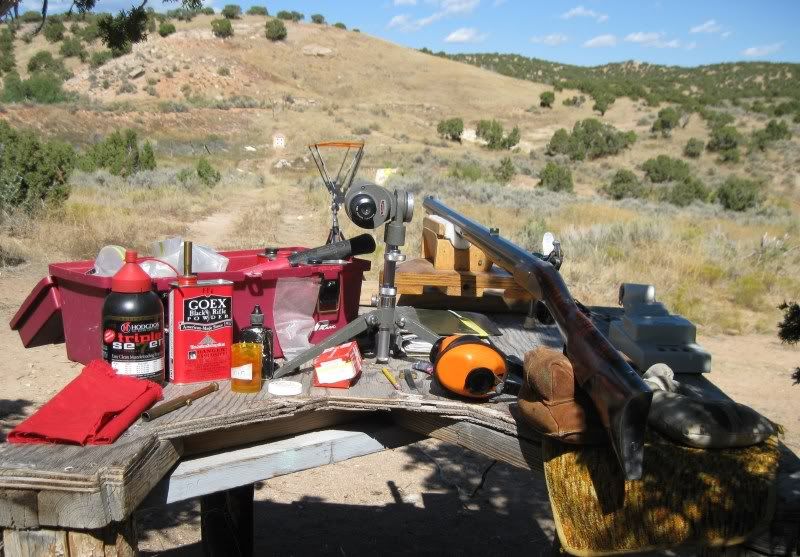
140 grains of Goex 2F gave 1721 fps, but required OverPowderWads (OPW), see Target 1 below. The large group may be due to my holding technique.
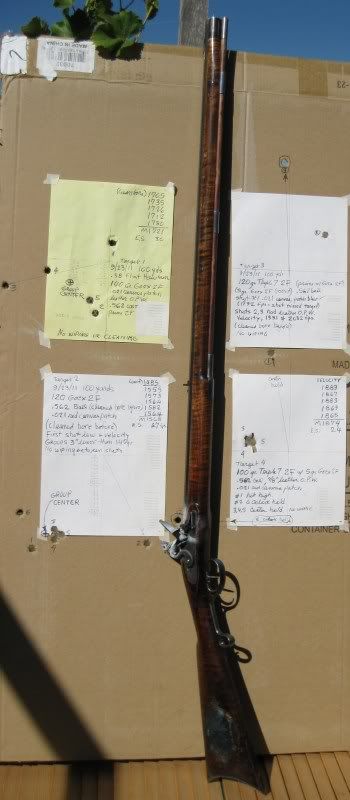
So I switched to 120 grains without an OPW, for simplicity and speed of reloading should I have to have a fast second shot at a bull. First shot with a clean bore was low in velocity. So I shot five more to have a five-shot velocity.
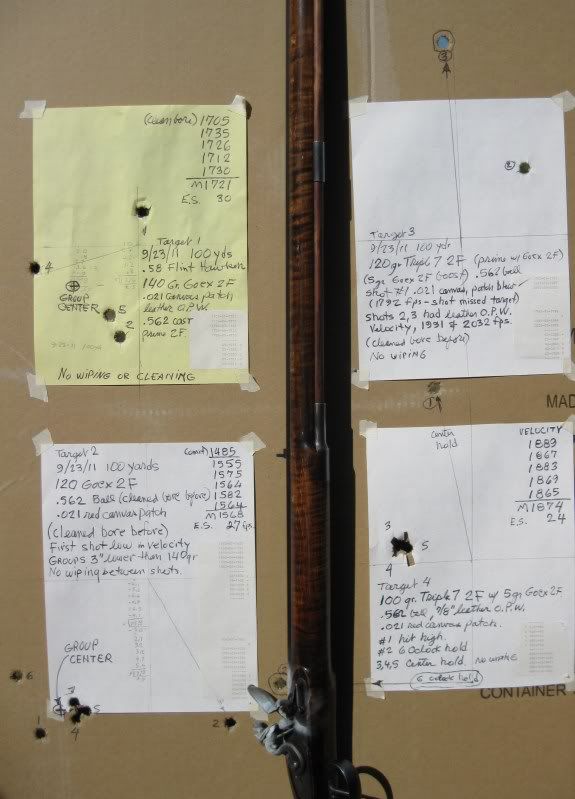
Had I not fired that sixth shot, the group was impressive (Target 2 below). But I did not quit while I was ahead.
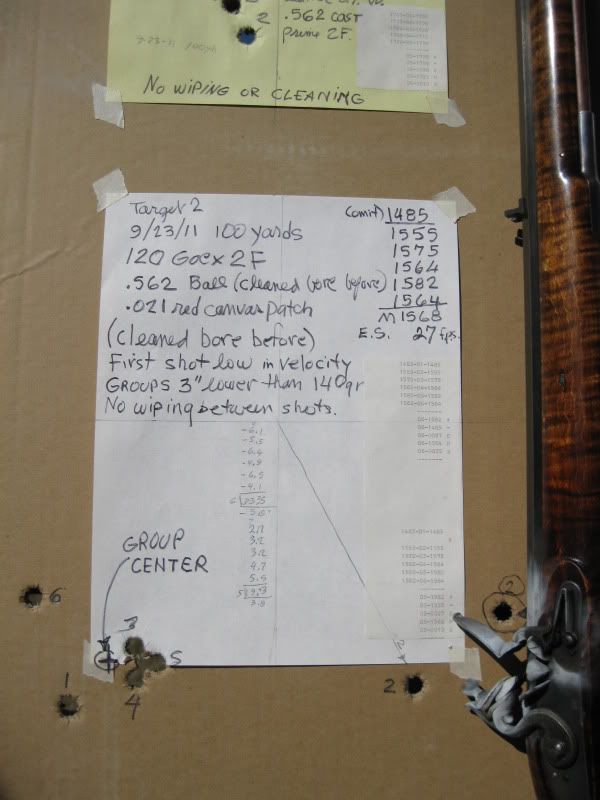
Then I shot some Triple 7 2F which I got in April, 2002 to see if it really had lost power and velocity as Paul V. claimed in the Smoothbore forum, "Triple 7 in Smoothbore". First shot was 120 grains of T7 2F with the .021 canvas patch, which blew to pieces, as I knew it would. Velocity 1792 fps, shot missed the entire target board. Shots 2 and 3, I used a leather OPW. Velocities were 1991 and 2032 fps and the bullets hit high. Do I dropped to 100 grains of T7 2F in a measure, tapped it to settle the powder 5 grains (marked inside the barrel of the measure), and topped that off with 5 grains of Goex 2f and poured it into the bore. I also primed with Goex 2F. First shot (Target 4, lower right) hit high. So I did a six-oclock hold, and the shot struck at that elevation, but to the side. I held center again and the last three shots are in one fat hole. I thought I might shoot another two to prove it wasn't a fluke, but since I had 5 good velocities, I quit while I was ahead. Velocity average was 1874 fps with a spread of 24 fps. This is my experience with Paul V's claim in the Smoothbore forum that Triple 7 loses power once the container is opened.
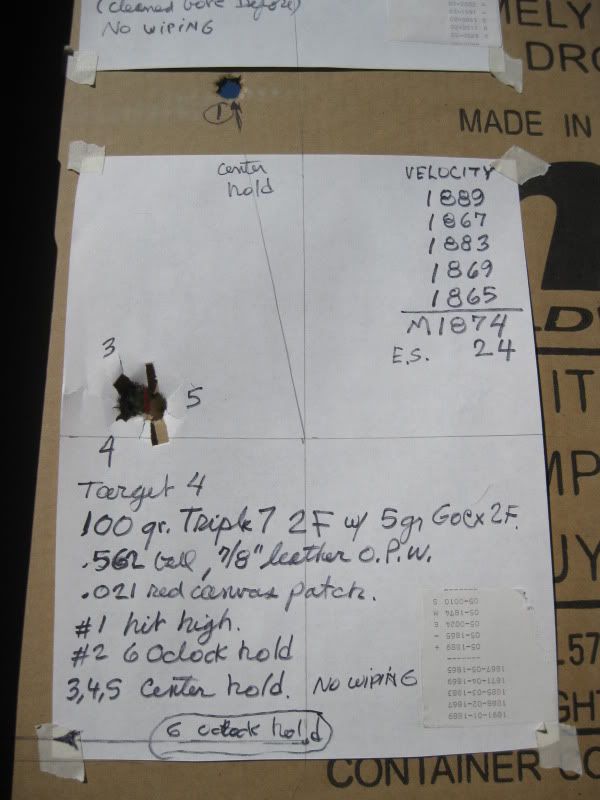
Here is the .021 canvas patching. First shot with no OPW, blew to pieces. Then the leather OPWs were used, these are T7 patches.
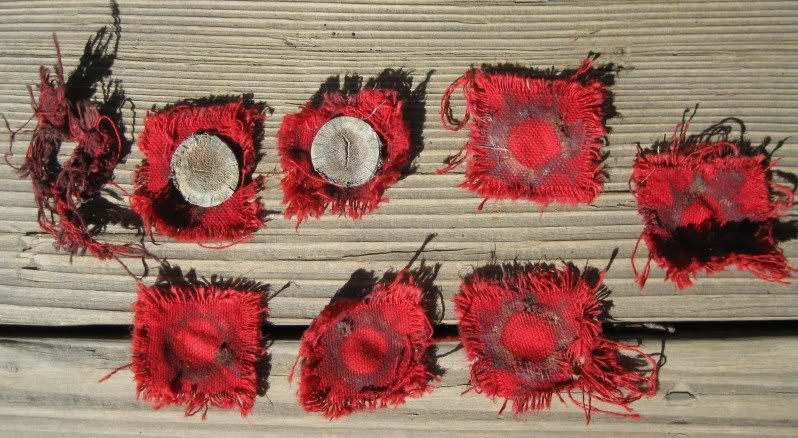
Here is the lock of my Hawken, with the flint hooked breech. There is a chamber in the breech, was .360 in diameter and powder bridged in it. I finally drilled it out to .440, and the smoked dowel shows the size and length of that powder chamber. Smaller diameter chambers can cause powder bridging, even with Goex 2F and Swiss 2 and 1 1/2 powders, causing ignition failure. The Triple 7 in this rifle is entirely reliable, I never had a failure to fire, but I will not use it in my elk hunt, wanting to be traditional.
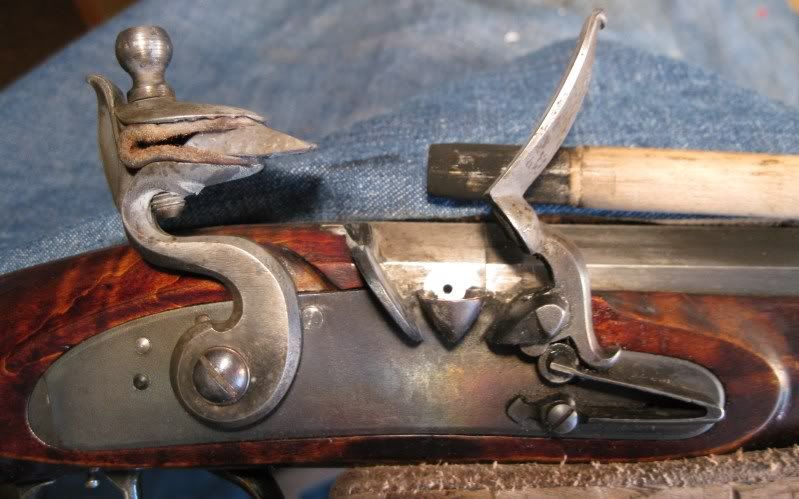

140 grains of Goex 2F gave 1721 fps, but required OverPowderWads (OPW), see Target 1 below. The large group may be due to my holding technique.

So I switched to 120 grains without an OPW, for simplicity and speed of reloading should I have to have a fast second shot at a bull. First shot with a clean bore was low in velocity. So I shot five more to have a five-shot velocity.

Had I not fired that sixth shot, the group was impressive (Target 2 below). But I did not quit while I was ahead.

Then I shot some Triple 7 2F which I got in April, 2002 to see if it really had lost power and velocity as Paul V. claimed in the Smoothbore forum, "Triple 7 in Smoothbore". First shot was 120 grains of T7 2F with the .021 canvas patch, which blew to pieces, as I knew it would. Velocity 1792 fps, shot missed the entire target board. Shots 2 and 3, I used a leather OPW. Velocities were 1991 and 2032 fps and the bullets hit high. Do I dropped to 100 grains of T7 2F in a measure, tapped it to settle the powder 5 grains (marked inside the barrel of the measure), and topped that off with 5 grains of Goex 2f and poured it into the bore. I also primed with Goex 2F. First shot (Target 4, lower right) hit high. So I did a six-oclock hold, and the shot struck at that elevation, but to the side. I held center again and the last three shots are in one fat hole. I thought I might shoot another two to prove it wasn't a fluke, but since I had 5 good velocities, I quit while I was ahead. Velocity average was 1874 fps with a spread of 24 fps. This is my experience with Paul V's claim in the Smoothbore forum that Triple 7 loses power once the container is opened.

Here is the .021 canvas patching. First shot with no OPW, blew to pieces. Then the leather OPWs were used, these are T7 patches.

Here is the lock of my Hawken, with the flint hooked breech. There is a chamber in the breech, was .360 in diameter and powder bridged in it. I finally drilled it out to .440, and the smoked dowel shows the size and length of that powder chamber. Smaller diameter chambers can cause powder bridging, even with Goex 2F and Swiss 2 and 1 1/2 powders, causing ignition failure. The Triple 7 in this rifle is entirely reliable, I never had a failure to fire, but I will not use it in my elk hunt, wanting to be traditional.





